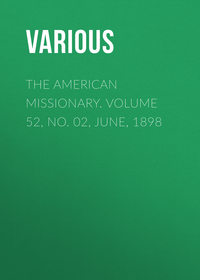 полная версия
полная версияBirds, Illustrated by Color Photography, Vol. 2, No. 5
THE CERULEAN WARBLER
THIS beautiful little sky-blue feathered creature is well named Azure Warbler, or again White-throated Blue Warbler, and is the most abundant of the genus here.
It is a bird of the wood, everywhere associated with the beautiful tall forests of the more northern counties of western New York, sometimes found in the open woods of pasture-lands, and quite partial to hardwood trees. In its flitting motion in search of insect-prey, and in the jerking curves of its more prolonged flight, as also in its structure, it is a genuine Wood Warbler and keeps for the most part to what Thoreau calls the “upper story” of its sylvan domain.
All Warblers, it has been said, depend upon their markings rather than song for their identity, which renders the majority of the tribe of greater interest to the scientist than to the novice. Until you have named four or five of the commonest species as landmarks, you will be considerably confused.
Audubon described the song of the Cerulean Warbler as “extremely sweet and mellow,” whereas it is a modest little strain, says Chapman, or trill, divided into syllables like zee, zee, zee, ze-ee-ee-eep, or according to another observer, rheet, rheet, rheet, rheet, ridi, idi, e-e-e-e-ee; beginning with several soft warbling notes and ending in a rather prolonged but quite musical squeak. The latter and more rapid part of the strain, which is given in the upward slide, approaches an insect quality of tone which is more or less peculiar to all true Warblers, a song so common as to be a universal characteristic of our tall forests.
It is not strange that the nest of this species has been so seldom discovered, even where the bird is very abundant during the breeding season. It is built in the higher horizontal branches of forest trees, always out some distance from the trunk, and ranging from twenty to fifty feet above the ground. One described by Dr. Brewer, found in Ontario, near Niagara Falls, was built in a large oak tree at the height of fifty or more feet from the ground. It was placed horizontally on the upper surface of a slender limb between two small twigs; and the branch on which it was thus saddled was only an inch and a half in thickness, being nine feet from the trunk of the tree. The abandoned home was secured with great difficulty.
The nest is a rather slender fabric, somewhat similar to the nest of the Redstart, and quite small for the bird, consisting chiefly of a strong rim firmly woven of strips of fine bark, stems of grasses, and pine needles, bound round with flaxen fibres of plants and wool. Around the base a few bits of hornets’ nests, mosses, and lichens are loosely fastened. The nest within is furnished with fine stems and needles, the flooring very thin and slight.
The bird is shy when started from the nest, and has a sharp chipping alarm-note common to the family.
The Cerulean Warbler is found in the Eastern States, but is more numerous west of the Allegheny mountains, and throughout the heavily wooded districts of the Mississippi valley. In winter it migrates to Central America and Cuba. The Warblers are of unfailing interest to the lover of bird life. Apart from the beauty of the birds themselves, with their perpetually contrasting colors among the green leaves, their pretty ways furnish to the silent watcher an ever changing spectacle of the innocent life in the tree-tops.
THE WILD TURKEY
I thought my picture would appear in this number of Birds. What would Thanksgiving be without a Turkey, I’d like to know.
The editor says that I am a bird of ex-tra-or-di-na-ry size and beauty. That word is as big as I am, but by spelling it, I guess you will understand.
I look as proud as a peacock, don’t I? Well, I am just as proud. You ought to see me strut, and hear me talk when the hen-turkeys are around. Why, sometimes when there is a large troop of us in the woods you can hear us gobble, gobble, gobble, for many miles. We are so fond of talking to each other.
That is when we are about to set up housekeeping, you think.
Yes, in March and April. After the nests are made, and the little turkeys hatched out, we big, handsome fellows go off by ourselves. The hen-turkeys, with their young broods, do the same.
Sometimes there are as many as a hundred in our troop and seventy or eighty in theirs. We travel on foot, picking up food as we go, till we meet a man with a gun, or come to a wide river.
Then we have to fly.
In a flock? Oh, yes. We choose some high place from which to get a good start. There we all stay, sometimes a day or two, strutting about and talking big. It is gobble, gobble gobble, from morning till night. Just like one of your conventions, you know. After awhile our leader gives the signal and off we all fly to the opposite shore.
Did you ever see one of our nests? No? Well, they are not easily seen, though they are made on the ground. You see, we are cunning and build them among tall, thick weeds and tangled briars.
I hope, if you ever come across one, you will not touch it, because my mate would never return to it again, if you did.
What do we eat?
Berries, fruit and grasses, beetles, tadpoles, frogs and lizards. In fact anything we consider good.
THE YELLOW-BILLED TROPIC BIRD
IN appearance this bird resembles a large Tern, and its habits are similar to those of the Terns. Inter-tropical, it is of a wandering disposition, breeding on the islands of mid-ocean thousands of miles apart. It is noted for its elegant, airy, and long-protracted flight. Davie says that on Bourbon, Mauritius and other islands east and south of Madagascar it breeds in the crevices of the rocks of inaccessible cliffs, and in hollow trees. In the Bermuda Islands it nests about the first of May in holes in high rocky places along the shores. Here its favorite resorts are the small islands of Great Sound, Castle Harbor, and Harrington Sound. The Phaeton, as it is felicitously called, nests in the Bahamas in holes in the perpendicular faces of cliffs and on the flat surfaces of rocks. A single egg is laid, which has a ground-color of purplish brownish white, covered in some specimens almost over the entire surface with fine reddish chocolate-colored spots.
These species compose the small but distinct family of tropic birds and are found throughout the tropical and sub-tropical regions of the world. Long journeys are made by them across the open sea, their flight when emigrating being strong, rapid, and direct, and immense distances are covered by them as they course undismayed by wind or storm. In feeding, Chapman says, they course over the water, beating back and forth at a height of about forty feet, and their long willowy tail-feathers add greatly to the grace and beauty of their appearance when on the wing. They are of rare and probably accidental occurrence on our coasts.
The Songs of Nature never cease,Her players sue not for releaseIn nearer fields, on hills afar,Attendant her musicians are:From water brook or forest tree,For aye comes gentle melody,The very air is music blent —An universal instrument.– John Vance Cheney.THE YELLOW-BILLED TROPIC BIRD
The people who make a study of birds say that I look like a large Tern, and that my habits are like his.
I don’t know whether that is so, I am sure, for I have no acquaintance with that bird, but you little folks can turn to your March number of Birds and see for yourselves if it is true.
For my part, I think I am the prettier of the two on account of my long, willowy tail-feathers. They add greatly, it is said, to the grace and beauty of my appearance when on the wing. Then, the color of my coat is much more beautiful than his, I think, don’t you think so, too?
We are not so common as the Terns, either, for they are very numerous. There are only three species of our family, so we consider ourselves quite distinct.
What are we noted for?
Well, principally for our long distance flights across the sea, elegant and airy, as the writers say of us. Maybe that is the reason they call us the Phaeton sometimes.
Do we go north in the summer as so many other birds do?
Ugh! You make me shudder. No, indeed! We never go farther north than Florida. Our home, or where we build our nests, is in the tropical and sub-tropical regions, where the weather is very warm, you know.
We are great wanderers and build our nests on islands, way out in the ocean many thousands of miles apart.
In trees?
Oh, no, but in any hole we see in the face of a great rock or cliff, and sometimes right on the top of a rock.
How many eggs?
Only one. That is the reason, you see, that our family remains small.
Sing?
Oh, my, no! We are not singing birds. We have a call-note, though harsh and guttural, which sounds like tip, tip, tip.
THE EUROPEAN KINGFISHER
RARELY indeed is this charming bird now found in England, where formerly it could be seen darting hither and thither in most frequented places. Of late years, according to Dixon, he has been persecuted so greatly, partly by the collector, who never fails to secure the brilliant creature for his cabinet at every opportunity, and partly by those who have an inherent love for destroying every living object around them. Gamekeepers, too, are up in arms against him, because of his inordinate love of preying on the finny tribe. Where the Kingfisher now is seen is in the most secluded places, the author adds, where the trout streams murmur through the silent woods, but seldom trod by the foot of man; or in the wooded gullies down which the stream from the mountains far above rushes and tumbles over the huge rocks, or lies in pools smooth as the finest mirror.
The Kingfisher is comparatively a silent bird, though he sometimes utters a few harsh notes as he flies swift as a meteor through the wooded glades. You not unfrequently flush the Kingfisher from the holes in the banks, and amongst the brambles skirting the stream. He roosts at night in holes, usually the nesting cavity. Sometimes he will alight on stumps and branches projecting from the water, and sit quiet and motionless, but on your approach he darts quickly away, often uttering a feeble seep, seep, as he goes.
The habits of the English Kingfisher are identical with those of the American, though the former is the more brilliant bird in plumage. (See Birds, Vol. I, p.) The ancients had a very absurd idea as to its nesting habits. They believed that the bird built a floating nest, and whenever the old bird and her charge were drifted by the winds, as they floated over the briny deep, the sea remained calm. He was, therefore, to the ancient mariner, a bird held sacred in the extreme. Even now these absurd superstitions have not wholly disappeared. For instance, the nest is said to be made of the fish bones ejected by the bird, while the real facts are, that they not only nest but roost in holes, and it must follow that vast quantities of rejected fish bones accumulate, and on these the eggs are of necessity laid.
These eggs are very beautiful objects, being of a deep pinkish hue, usually six in number.
The food of the Kingfisher is not composed entirely of fish, the remains of fresh-water shrimps being found in their stomachs, and doubtless other animals inhabiting the waters are from time to time devoured.
The English Kingfisher, says Dixon, remains throughout the year, but numbers perish when the native streams are frozen. There is, perhaps, not a bird in all the ranks of the feathered gems of equatorial regions, be it ever so fair, the Humming-bird excepted, that can boast a garb so lovely as this little creature of the northland. Naturalists assert that the sun has something to do with the brilliant colors of the birds and insects of the tropics, but certainly, the Kingfisher is an exception of the highest kind. Alas, that he has no song to inspire the muse of some English bard!
THE EUROPEAN KINGFISHER
Little Folks:
I shouldn’t have liked it one bit if my picture had been left out of this beautiful book. My cousin, the American Kingfisher, had his in the February number, and I find he had a good deal to say about himself in his letter, too.
Fine feathers make fine birds, they say. Well, if that is true, I must be a very fine bird, for surely my feathers are gay enough to please anybody —I think.
To see me in all my beauty, you must seek me in my native wood. I look perfectly gorgeous there, flitting from tree to tree. Or maybe you would rather see me sitting on a stump, gazing down into the clear pool which looks like a mirror.
“Oh, what a vain bird!” you would say; “see him looking at himself in the water;” when all the time I had my eye on a fine trout which I intended to catch for my dinner.
Well, though I wear a brighter dress than my American cousin, our habits are pretty much alike. I am sure he catches fish the same way I do – when he is hungry.
With a hook and line, as you do?
Oh, no; with my bill, which is long, you observe, and made for that very purpose. You should just see me catch a fish! Down I fly to a stump near the brook, or to a limb of a tree which overhangs the water, and there I sit as quiet as a mouse for quite a while.
Everything being so quiet, a fine speckled trout, or a school of troutlets, play near the surface. Now is my chance! Down I swoop, and up I come with a fish crosswise in my bill.
Back I go to my perch, toss the minnow into the air, and as it falls catch it head first and swallow it whole. I tell you this because you ought to know why I am called Kingfisher.
Do we swallow bones and all?
Yes, but we afterwards eject the bones, when we are resting or roosting in our holes in the banks of the stream. That must be the reason people who write about us say we build our nests of fish bones.
Sing?
Oh, no, we are not singing birds; but sometimes, when flying swiftly through the air, we give a harsh cry that nobody but a bird understands.
Your friend,The English Kingfisher.THE VERMILION FLY-CATCHER
THICKETS along water courses are favorite resorts of this beautiful Fly-catcher, which may be seen only on the southern border of the United States, south through Mexico to Guatemala, where it is a common species. Mr. W. E. D. Scott notes it as a common species about Riverside, Tucson, and Florence, Arizona. Its habits are quite similar to those of other Fly-catchers, though it has not been so carefully observed as its many cousins in other parts of the country. During the nesting season, the male frequently utters a twittering song while poised in the air, in the manner of the Sparrow Hawk, and during the song it snaps its bill as if catching insects.
The Vermilion’s nest is usually placed in horizontal forks of ratana trees, and often in mesquites, not more than six feet from the ground; they are composed of small twigs and soft materials felted together, with the rims covered with lichens, and the shallow cavity lined with a few horse or cow hairs. Dr. Merrill states that they bear considerable resemblance to nests of the Wood Pewee in appearance and the manner in which they are saddled to the limb. Nests have been found, however, which lacked the exterior coating of lichens.
Three eggs are laid of a rich creamy-white with a ring of large brown and lilac blotches at the larger end.
A WINTER NEST
Pallid, wan-faced cloudsPress close to the frozen pines,And follow the jagged linesOf fence, that the sleet enshrouds.Sharp in the face of the sky,Gaunt, thin-ribbed leaves are blown;They rise with a shuddering moan,Then sink in the snow and die.At the edge of the wood a vineStill clings to the sleeping beech,While its stiffened tendrils reachA nest, and around it twine.A little gray nest all alone,With its feathery lining of snow,Where bleak winds, piping low,Croon a sweet minor tone.– Nora A. Piper.BIRD MISCELLANY
Red and yellow, green and brown,Leaves are whirling, rustling down;Acorn babes in their cradles lie,Through the bare trees the brown birds fly;The Robin chirps as he flutters past —November days have come at last.– Clara Louise Strong.“I have watched birds at their singing under many and widely differing circumstances, and I am sure that they express joyous anticipation, present content, and pleasant recollection, each as the mood moves, and with equal ease.”
– M. Thompson.“The act of singing is evidently a pleasurable one; and it probably serves as an outlet for superabundant nervous energy and excitement, just as dancing, singing, and field sports do with us.”
– A. R. Wallace.“The bird upon the tree utters the meaning of the wind – a voice of the grass and wild flower, words of the green leaf; they speak through that slender tone. Sweetness of dew and rifts of sunshine, the dark hawthorn touched with breadths of open bud, the odor of the air, the color of the daffodil – all that is delicious and beloved of spring-time are expressed in his song.”
– Richard Jefferies.THE LAZULI BUNTING
The joy is great of him who straysIn shady woods on summer days.– Maurice Thompson.IN Colorado and Arizona the Lazuli Painted Finch, as it is called, is common, while in California it is very abundant, being, in fact, generally distributed throughout the west, and along the Pacific Coast it is found as far north as Puget Sound, during the summer. Davie says it replaces the Indigo Bunting, from the Plains to the Pacific, being found in all suitable localities. The nest is usually built in a bush or in the lower limbs of trees, a few feet from the ground. Fine strips of bark, small twigs, grasses, and hair are used in preparing it for the four tiny, light bluish-green eggs, which readily fade when exposed to light. The eggs so closely resemble those of the Bluebird as not to be distinguishable with certainty. The nest is an inartistic one for a bird of gay plumage.
From Florence A. Merriam’s charming book, “A-Birding on a Bronco,” we select a description of the pretty manners of this attractive bird. She says:
“While waiting for the Woodpeckers, one day, I saw a small brownish bird flying busily back and forth to some green weeds. She was joined by her mate, a handsome blue Lazuli Bunting, even more beautiful than our lovely Indigo, and he flew beside her full of life and joy. He lit on the side of a cockle stem, and on the instant caught sight of me. Alas! he seemed suddenly turned to stone. He held onto that stalk as if his little legs had been bars of iron and I a devouring monster. When he had collected his wits enough to fly off, instead of the careless gay flight with which he had come out through the open air, he timidly kept low within the cockle field, making a circuitous way through the high stalks. He could be afraid of me if he liked, I thought, for after a certain amount of suspicion, an innocent person gets resentful; at any rate I was going to see that nest. Creeping up cautiously when the mother bird was away, so as not to scare her, and carefully parting the mallows, I looked in. Yes, there it was, a beautiful little sage-green nest of old grass laid in a coil. I felt as pleased as if having a right to share the family happiness. After that I watched the small worker gather material with new interest, knowing where she was going to put it. She worked fast, but did not take the first thing she found, by any means. With a flit of the wing she went in nervous haste from cockle to cockle, looking eagerly about her. Jumping down to the ground, she picked up a bit of grass, threw it down dissatisfied, and turned away like a person looking for something. At last she lit on the side of a thistle, and tweaking out a fibre, flew with it to the nest.
“A month after the first encounter with the father Lazuli, I found him looking at me around the corner of a cockle stalk, and in passing back again, caught him singing full tilt, though his bill was full of insects! After we had turned our backs I looked over my shoulder and had the satisfaction of seeing him take his beakful to the nest. You couldn’t help admiring him, for though not a warrior who would snap his bill over the head of an enemy of his home, he had a gallant holiday air with his blue coat and merry song, and you felt sure his little brown mate would get cheer and courage enough from his presence to make family dangers appear less frightful.”
THE LAZULI BUNTING
You think you have seen me before? Well, I must admit my relative, the Indigo Bunting, and I do look alike. They say though, I am the prettier bird of the two. Turn to your May number, page , and decide for yourselves.
I live farther west than he does. You find him in the eastern and middle states. Then he disappears and I take his place, all the way from the Great Plains to the Pacific Ocean.
Some people call me the Lazuli Painted Finch. That’s funny, for I never painted anything in my life – not even my cheeks. Would you like to know how my mate and I go to housekeeping? A lady who visits California, where I live, will tell you all about it. She rides a horse called Mountain Billy. He will stand still under a tree so that she can peep into nests and count the eggs, when the mother bird is away.
She can travel a good many miles in that way, and meet lots of birds. She says in her book, that she has got acquainted with seventy-five families, without robbing one nest, or doing the little creatures any harm.
Well, one day this lady saw a brownish bird flying busily back and forth to some tall green weeds. After a while a handsome blue Bunting flew along side of her, full of life and joy.
That was my mate and I. How frightened I was! for our nest was in those green weeds and not very far from the ground. I flew away as soon as I could pluck up courage, but not far, so that I could watch the lady and the nest. How my heart jumped when I saw her creep up, part the weeds and look in. All she saw was a few twigs and a sage-green nest of old grass laid in a coil. My mate hadn’t put in the lining yet; you see it takes her quite a while to get the thistle down and the hair and strips of bark for the inside. The next time the lady passed, the house was done and my mate was sitting on the nest. She just looked down at us from the back of Mountain Billy and passed on.
Four weeks after, she came again, and there I was, flying about and singing “like a bird,” my mouth full of insects, too. I waited ’till she had turned away before I flew to the nest to feed our little ones. I didn’t know, you see, that she was such a good friend of ours, or I wouldn’t have been so afraid.
SUMMARY
Page 163.
SUMMER TANAGER.—Piranga rubra. Other names: “Summer Red-bird,” “Rose Tanager.”
Range – Eastern United States west to the edge of the Plains; north regularly to about 40° – New Jersey, central Ohio, Illinois, casually north to Connecticut and Ontario, accidentally to Nova Scotia, wintering in Cuba, Central America, and northern South America. (Davie.)
Nest – Of bark strips and leaves interwoven with various vegetable substances, on drooping branch of tree.
Eggs – Three or four, bluish-white or greenish-blue, with cinnamon or olive-brown markings.
Page 168.
AMERICAN WHITE-FRONTED GOOSE—Anser albifrons gambeli. Other names: “Laughing Goose,” “Speckle Belly.”
Range – North America, breeding far northward; in winter south to Mexico and Cuba, rare on the Atlantic coast.
Nest – On the ground, of grasses lined with down.
Eggs – Six or seven, dull greenish-yellow with obscure darker tints.
Page 171.
TURNSTONE.—Arenaria interpres. Other names: “Brant Bird,” “Calico-back,” “Bead-bird,” “Sand-runner,” “Chickling,” “Horse-foot Snipe.”
Range – Nearly cosmopolitan; nests in the Arctic regions, and in America migrates southward to Patagonia. (Chapman.)
Nest – A slight depression on the ground.
Eggs – Two or four, greenish-drab, spotted all over with brown.
Page 175.
THE BELTED PIPING PLOVER.—Aegialitis meloda circumcincta.
Range – Missouri river region; occasionally eastward to the Atlantic coast.









